
A chloroplast is a type of membrane-bound organelle known as a plastid that conducts photosynthesis mostly in plant and algal cells. The photosynthetic pigment chlorophyll captures the energy from sunlight, converts it, and stores it in the energy-storage molecules ATP and NADPH while freeing oxygen from water in the cells. The ATP and NADPH is then used to make organic molecules from carbon dioxide in a process known as the Calvin cycle. Chloroplasts carry out a number of other functions, including fatty acid synthesis, amino acid synthesis, and the immune response in plants. The number of chloroplasts per cell varies from one, in unicellular algae, up to 100 in plants like Arabidopsis and wheat.

Photosynthesis is a biological process used by many cellular organisms to convert light energy into chemical energy, which is stored in organic compounds that can later be metabolized through cellular respiration to fuel the organism's activities. The term usually refers to oxygenic photosynthesis, where oxygen is produced as a byproduct and some of the chemical energy produced is stored in carbohydrate molecules such as sugars, starch, glycogen and cellulose, which are synthesized from endergonic reaction of carbon dioxide with water. Most plants, algae and cyanobacteria perform photosynthesis; such organisms are called photoautotrophs. Photosynthesis is largely responsible for producing and maintaining the oxygen content of the Earth's atmosphere, and supplies most of the biological energy necessary for complex life on Earth.

Amaranthaceae is a family of flowering plants commonly known as the amaranth family, in reference to its type genus Amaranthus. It includes the former goosefoot family Chenopodiaceae and contains about 165 genera and 2,040 species, making it the most species-rich lineage within its parent order, Caryophyllales.

C4 carbon fixation or the Hatch–Slack pathway is one of three known photosynthetic processes of carbon fixation in plants. It owes the names to the 1960s discovery by Marshall Davidson Hatch and Charles Roger Slack that some plants, when supplied with 14CO2, incorporate the 14C label into four-carbon molecules first.

Photorespiration (also known as the oxidative photosynthetic carbon cycle or C2 cycle) refers to a process in plant metabolism where the enzyme RuBisCO oxygenates RuBP, wasting some of the energy produced by photosynthesis. The desired reaction is the addition of carbon dioxide to RuBP (carboxylation), a key step in the Calvin–Benson cycle, but approximately 25% of reactions by RuBisCO instead add oxygen to RuBP (oxygenation), creating a product that cannot be used within the Calvin–Benson cycle. This process lowers the efficiency of photosynthesis, potentially lowering photosynthetic output by 25% in C3 plants. Photorespiration involves a complex network of enzyme reactions that exchange metabolites between chloroplasts, leaf peroxisomes and mitochondria.
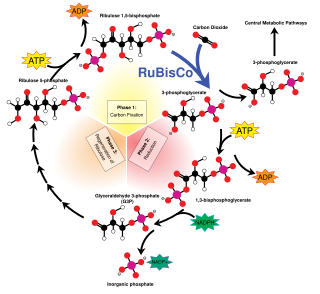
C3 carbon fixation is the most common of three metabolic pathways for carbon fixation in photosynthesis, the other two being C4 and CAM. This process converts carbon dioxide and ribulose bisphosphate (RuBP, a 5-carbon sugar) into two molecules of 3-phosphoglycerate through the following reaction:

The Salsoloideae are a subfamily of the Amaranthaceae, formerly in family Chenopodiaceae.
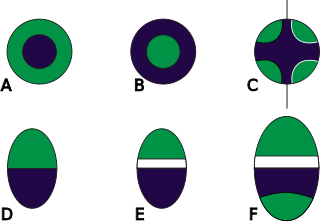
A vascular bundle is a part of the transport system in vascular plants. The transport itself happens in the stem, which exists in two forms: xylem and phloem. Both these tissues are present in a vascular bundle, which in addition will include supporting and protective tissues. In addition, there is also a tissue between xylem and phloem which is the cambium.
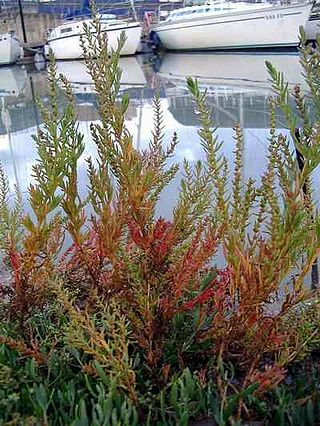
Suaeda is a genus of plants also known as seepweeds and sea-blites. Most species are confined to saline or alkaline soil habitats, such as coastal salt-flats and tidal wetlands. Many species have thick, succulent leaves, a characteristic seen in various plant genera that thrive in salty habitats.

Malate dehydrogenase (oxaloacetate-decarboxylating) (NADP+) (EC 1.1.1.40) or NADP-malic enzyme (NADP-ME) is an enzyme that catalyzes the chemical reaction in the presence of a bivalent metal ion:

Tecticornia pergranulata is a succulent halophytic plant species in the family Chenopodiaceae, native to Australia. This plant is commonly tested in labs involving its C3 photosynthesis and its unique resistance to salinity and adversity.

Halothamnus is a genus in the subfamily Salsoloideae of the family Amaranthaceae. The scientific name means saltbush, from the Greek ἅλς (hals) "salt" and θαμνος (thamnos) "bush". This refers either to salty habitats or to the accumulation of salt in the plants. The genus is distributed from Southwest and Central Asia to the Arabian peninsula and East Africa.
Suaeda aralocaspica is a species of plant in the family Amaranthaceae that is restricted to the deserts of Central Asia. It is a halophyte and uses C4 carbon fixation but lacks the characteristic leaf anatomy of other C4 plants (known as kranz anatomy). Carrying out complete C4 photosynthesis within individual cells, these plants instead are known as single‐cell C4 system or SCC4 plants. This makes them distinct from typical C4 plants, which require the collaboration of two types of photosynthetic cells. SCC4 plants have features that make them potentially valuable in engineering higher photosynthetic efficiencies in agriculturally important C3 carbon fixation species such as rice. To address this, the 467 Mb genome of S. aralocaspica has been sequenced to help understanding of the evolution of SCC4 photosynthesis and contribute to the engineering of C4 photosynthesis into other economically important crops.
Stomatal conductance, usually measured in mmol m−2 s−1 by a porometer, estimates the rate of gas exchange and transpiration through the leaf stomata as determined by the degree of stomatal aperture.

The Suaedoideae are a subfamily of plants in the family Amaranthaceae.
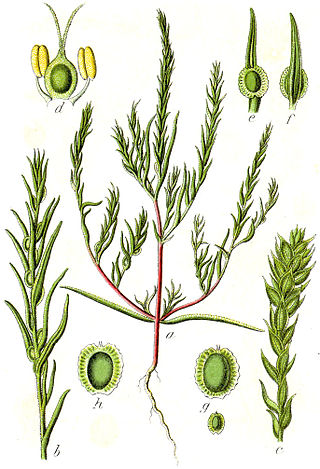
The Corispermoideae are a subfamily of the Amaranthaceae, formerly in family Chenopodiaceae.
The evolution of photosynthesis refers to the origin and subsequent evolution of photosynthesis, the process by which light energy is used to assemble sugars from carbon dioxide and a hydrogen and electron source such as water. The process of photosynthesis was discovered by Jan Ingenhousz, a Dutch-born British physician and scientist, first publishing about it in 1779.
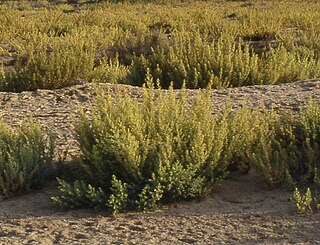
Bienertia is a flowering plant genus that currently is classified in the family Amaranthaceae s.l.. For long time, the genus was considered to consist only of one species, Bienertia cycloptera, but in 2005 and 2012, two new species have been separated.

Bienertia cycloptera is a species of flowering plant that is native to the Middle East, south-eastern Europe, and central Asia. It is a succulent, smooth annual plant with long, curved, cylindrical leaves. Its flowers have both male and female reproducing parts and its fruits are small and spherical. Bienertia cycloptera grows in hot, dry climates with little rainfall and tolerates soils with high salinity levels very well. Due to its specific growing conditions, B. cycloptera is not a very common, nor widespread plant. Even over most of its range, it often grows sparsely in small patches of growth. One notable aspect of Bienertia cycloptera is its unique C4 photosynthesis mechanism. Unlike most C4 plants, in B. cycloptera the photosynthetic mechanism occurs within a single chlorenchyma cell, without Kranz anatomy.
















